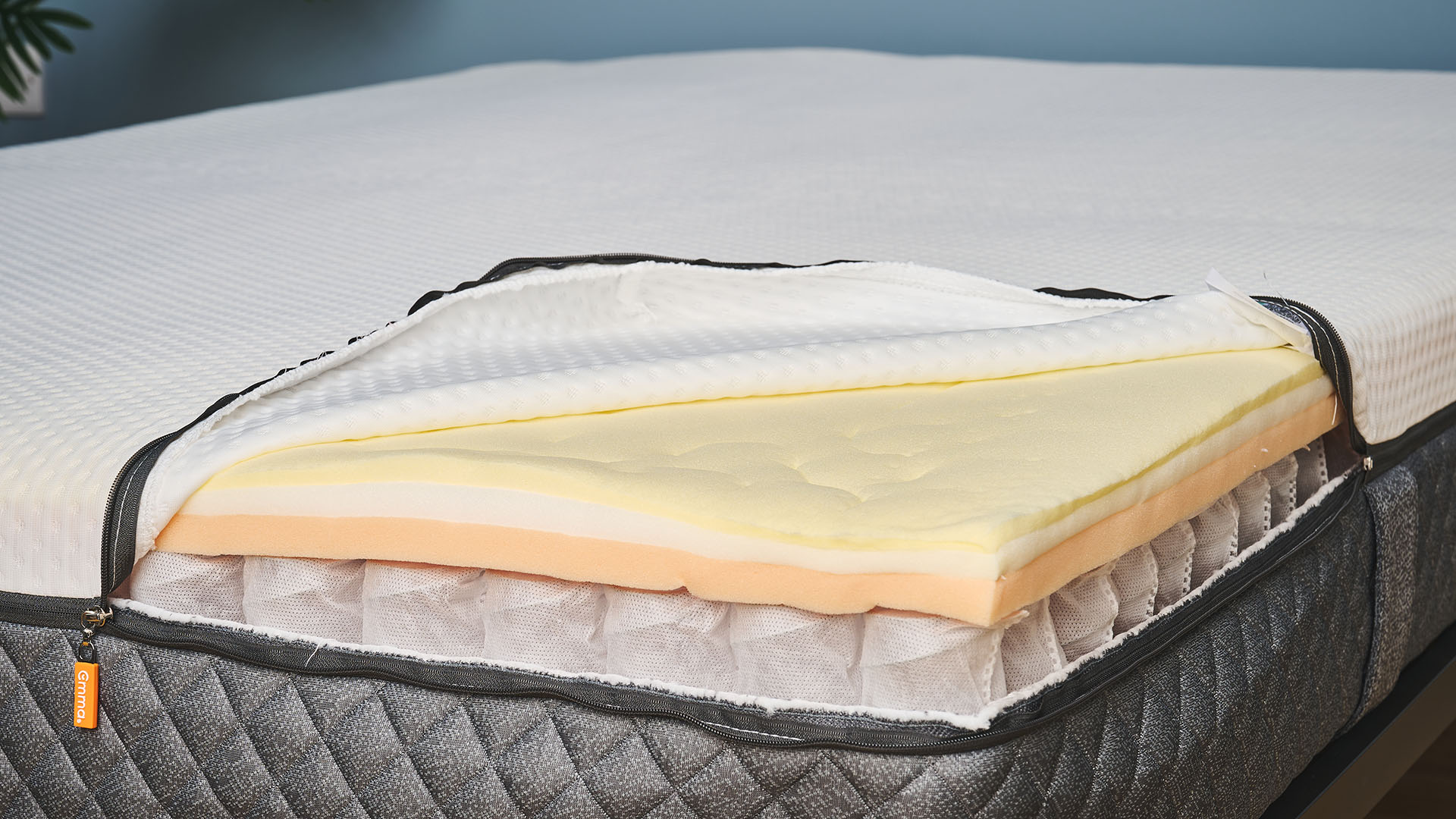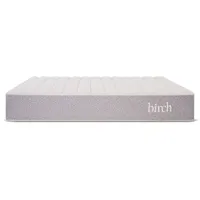What are the benefits to buying a hybrid mattress?
Why you should consider these breathable and bouncy beds

Browsing our guide to the best hybrid mattresses and wondering whether this type of bed is right for you? Most of the best mattresses around are hybrids, and there are some excellent advantages to this build style. So if you're shopping for a new bed, it's a good place to start.
By definition, hybrid mattresses are multi-layered mattresses that contain at least two different types of materials. It can be any combination of materials, but hybrids usually combine springs with some kind of foam. And while their properties vary depending on their exact design, hybrid beds can be excellent at delivering support, pressure relief, and cooling.
We've taken a look at the down-sides of buying a hybrid mattress, but now it's time to explore the flip-side: what are the advantages of buying a hybrid bed? And as you're about to find out, there's quite a few of them. Let's get started...
#1. Good temperature regulation
If you tend to wake up sweaty and uncomfortable – even in the middle of winter – then you want to pay attention to this performance factor. A mattress with good temperature regulation stays an even, cooler, temperature throughout the night to prevent you from overheating. And it's an area where hybrids beds can excel.

The dense structure of mattress foams mean they can cling on to body heat. Manufacturers have come up with all kinds of fancy ways to stop memory foam mattresses from sleeping hot – we’re talking copper-infusions, phase-change materials, perforated air channels, and that’s just the tip of the all-foam cooling iceberg. But if your mattress also contains coils, it's always going to be better at regulating temperature. The gaps between the springs leave space for air to circulate, allowing heat to dissipate.
Of course, some hybrid mattresses are better than others at cooling. If your hybrid has a thick layer of memory foam at the top, it still might run a bit warm. But, overall, we expect the majority of hybrid mattresses to offer better temperature regulation than an all-foam mattress. (If you really struggle with overheating at night, you want one of the best cooling mattresses.)
Helix Midnight mattress
The Helix Midnight is softer than you might expect from a hybrid, but thanks to those coils, it's still very breathable (our reviewer gave it 4.5/5 for temperature regulation in our Helix Midnight mattress review). An excellent choice if you struggle with night sweats but still want a softer build.
#2. Stronger edge support
If the center of your mattress feels sturdy but the sides sink as soon as you sit on them, your bed has bad edge support. Edge support refers to how stable the perimeter of the mattress is, and it’s a necessary component if you push against the edge of the bed to get up in the morning (particularly for those with poor mobility). It’s also an important feature for those who share a bed, especially if your partner likes to stretch and you often find yourself clinging to the edges.
Sign up for breaking news, reviews, opinion, top tech deals, and more.

Overall, hybrids tend to have better edge support than all-foam mattresses. Hybrid beds can increase edge support by using thicker, stronger coils at the perimeter, adding foam railings to the side, or a combination of the two. If you want to starfish across the full surface of the bed without feeling like you're rolling off, it's worth considering a hybrid.
DreamCloud mattress
Thicker coils around the perimeter give the DreamCloud strong edge support, so you can lie on the edge without the bed sinking beneath you. This is just one of the features we love about the luxurious feeling DreamCloud – you can learn more with our DreamCloud mattress review.
#3. They’re easy to move around on
The spring layer found in most hybrids makes them more responsive and easier to change position on, compared to a slow-moving foam mattress. With a bouncy hybrid, you can switch sides and the surface will meet your new position almost immediately, allowing you to stay comfortably supported even if you toss and turn. Beds with more sink, like many of the best memory foam mattresses, can be a struggle to move around on, as the foams hold onto your old position.
Birch Natural Hybrid mattress
Balancing bouncy springs with equally-bouncy latex foams, the Birch Natural mattress is an excellent choice for anyone who likes freedom to move during the night. There's some light contouring, but none of the sink that can keep you stuck in place. Head to our Birch Natural Hybrid mattress review to learn more.
#4. They suit back and stomach sleepers
We tend to associate hybrid mattresses with a firmer feel and memory foam mattresses with a softer feel. Now, there’s lots of variation within that (there are softer hybrids and firmer memory foam mattresses) but broadly, hybrid beds have a more supportive feel than a cushioned memory foam.

This makes them a good choice for those who sleep on their back or stomach and therefore requires extra support at the hips or lower back. We also recommend hybrids for those with heavier bodies, as the combination of coils and cushion materials can provide head-to-toe support. All the mattresses in our best mattress for bigger bodies guide are hybrids.
Helix Dusk Luxe
The Helix Dusk Luxe doesn't have the firm feel we might expect from a bed for back and stomach sleepers, but this hybrid does have a bouncy and supportive build that prevents you from sinking too far into the cloud-like surface. Learn more with our Helix Dusk Luxe mattress review.
WinkBed Plus mattress
Designed with a combination of high density foams, zoned latex, and EliteEdge support coils, the WinkBed uses its firm and sturdy build to offer a comfortable sleep solution for heavier individuals.
#5. Hybrids are versatile
Hybrids are mattresses that combine two types of materials – and that leaves a lot of room for variation. Typically, hybrids consist of springs and foams. Some use more springs and less foam, others opt for more foam, less springs, and some have an even balance of the two. Check out two of our favorite hybrids – the Saatva Classic and the Helix Midnight. In our Saatva Classic mattress review, we noted the thin layer of foam meant this hybrid felt more like an innerspring mattress. Whereas in our Helix Midnight review, we found the multiple layers of foam created a more sumptuous experience.

You can also find a wide range of comfort materials used in hybrids. Some stick with softer memory foams, others use latex (most of our best organic mattresses combine springs with latex), and you can even find natural cushioning materials, such as wool. And there are plenty of spring variations to consider as well. Although many hybrids use just one layer of springs, some have multiple, including layers of responsive micro-coils.
And a hybrid doesn't need to be springs and coils. That might be what we expect from a hybrid mattress, but technically any material combination can count. Check out our Purple mattress review – this bed contains a GelFlex Grid and foams, giving it a completely unique feel.
All this results in a style of bed that suits a vast range of people. So if you're thinking of buying a new mattress, a hybrid is a great place to start trying out different surface feels, to see what you need in a bed.
Saatva Classic mattress
The Saatva Classic mattress is a good example of just how versatile a hybrid can be. Available in three firmness levels – Plush Soft, Luxury Firm, and Firm – as well as two heights, you can personalize your Saatva Classic to get a feel that's just right for you.
Purple mattress
The Purple mattress is a hybrid like no other. Instead of springs, it adds a GelFlex Grid to the multiple foam layers. This grid is breathable and contouring, quickly adapting to your shape to provide a type of support unlike any other hybrid.

Ruth is TechRadar’s Sleep Writer. She’s here to help you find the perfect sleep setup for your budget and personal preferences. As well as keeping a keen eye on everything that’s going on in the world of mattresses, she regularly speaks to experts to help you learn how to improve your sleep habits, whether that’s by debunking sleep myths or explaining the science behind it all. Prior to joining the TechRadar team, she wrote features and product guides for new parents hoping to get a decent night's sleep, as well as writing for a variety of online spaces.






